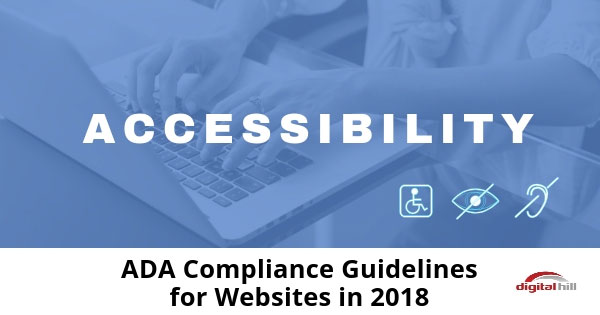ADA Compliance Guidelines for Websites in 2018

To give differently abled people an equal opportunity to enjoy the internet, website information should be accessible for the visually impaired and people that can’t use their hands.
For this reason, the Americans with Disability Act (ADA) was enacted. It provides guidelines to make public information and facilities more accessible to people with disabilities. Passed in 1990, the Act was originally for physical accommodations but has since been expanded to include website compliance.
Since a breach of these guidelines could result in fines and potential lawsuits, you need to understand what’s required and take measures to remain in compliance. Here’s everything you need to know about the ADA website regulations in 2018.
The January 2018 ADA Update
The United States Access Board announced first announced a review of the national website accessibility requirements after realizing that standards were incomplete and didn’t take into account evolving technologies. Public websites, software, and hardware gave disabled users many barriers to use.
The update aligned the standards with other guidelines issued by the EU and the Web Content Accessibility Guidelines (WCAG 2.0). They became active in January of 2018.
WCAG is Updating Again
WCAG 2.1 expands accessibility to a wider variety of disabilities. It takes into consideration people with low vision, speech disabilities, learning disabilities, and multiple disabilities.
The new guidelines aim to enhance accessibility on small screens and make common mobile device features accessible to everyone. It also takes into account emerging technologies such as driverless cars by requiring technologies be made barrier-free for people with disabilities.
What Are Your Responsibilities as a Website Owner?
Basically, the updated WCAG guidelines require that website owners should make web content accessible to a wider range of people with disabilities. Accessible content, under the new guidelines, means it is:
Perceivable
To make content perceivable, provide alternative text for non-text content so it can be converted to braille, print, speech, and symbols. Also, provide captions and other alternatives for multimedia, and make content easier to see and hear with high contrast text and background.
Operable
Operable content is designed in a way that doesn’t cause seizures and helps users navigate and find content easily. Also, all functionality must be available from the keyboard.
Understandable
Content is said to be understandable if it’s readable and easy to comprehend. The content should appear and operate in different ways for easier access and manipulation.
Robust
Web content is compatible with current and future assistive technologies on both mobile devices and personal computers.
Consider Action
Does your site need updating? We cannot provide legal advice on this but many sites do need updates in order to comply. A redesign or website update may be needed to comply with the new ADA and WCAG regulations. Key functions include having a function on the site where users can enlarge text and ensuring that all images on the site have Alt Descriptions so that the visually challenged using site reader tools have access to the image descriptions.
Make Your WordPress Website ADA Compliant with Plugins
Contact us to discuss further and consider a review of the options for your website.
